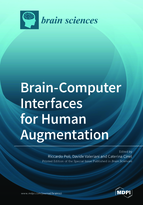Brain-Computer Interfaces for Human Augmentation
A special issue of Brain Sciences (ISSN 2076-3425).
Deadline for manuscript submissions: closed (30 September 2018) | Viewed by 51519
Special Issue Editors
Interests: brain–computer interfaces; evolutionary algorithms; machine learning; artificial intelligence
Interests: brain–computer interfaces; decision making; machine learning; artificial intelligence
Interests: multisensory integration; visual feature integration; attention; EEG; brain–computer interfaces; decision making; transcranial current stimulation; autobiographical memory
Special Issues, Collections and Topics in MDPI journals
Special Issue Information
Dear Colleagues,
The field of Brain–Computer Interfaces (BCIs) has grown rapidly in the last few decades, allowing the development of faster and more reliable assistive technologies based on direct links between the brain and an external device. Novel applications of BCIs have also been proposed, especially in the area of human augmentation, i.e., enabling people to go beyond human limitations in sensory, cognitive and motor tasks. Brain-imaging techniques, such as electroencephalography, have been used to extract neural correlates of various brain processes and transform them, via machine learning, into commands for external devices. Brain stimulation technology has allowed to trigger the activation of specific brain areas to enhance the cognitive processes associated to the task at hand, hence improving performance. BCIs have therefore extended their scope from assistive technologies for people with disabilities to neuro-tools for human enhancement. This Special Issue aims at showing the recent advances in BCIs for human augmentation, highlighting new results on both traditional and novel applications. These include, but are not limited to, control of external devices, communication, cognitive enhancement, decision making and entertainment. We look forward to receiving your contribution to this Special Issue.
Prof. Riccardo Poli
Dr. Davide Valeriani
Dr. Caterina Cinel
Guest Editors
Manuscript Submission Information
Manuscripts should be submitted online at www.mdpi.com by registering and logging in to this website. Once you are registered, click here to go to the submission form. Manuscripts can be submitted until the deadline. All submissions that pass pre-check are peer-reviewed. Accepted papers will be published continuously in the journal (as soon as accepted) and will be listed together on the special issue website. Research articles, review articles as well as short communications are invited. For planned papers, a title and short abstract (about 100 words) can be sent to the Editorial Office for announcement on this website.
Submitted manuscripts should not have been published previously, nor be under consideration for publication elsewhere (except conference proceedings papers). All manuscripts are thoroughly refereed through a single-blind peer-review process. A guide for authors and other relevant information for submission of manuscripts is available on the Instructions for Authors page. Brain Sciences is an international peer-reviewed open access monthly journal published by MDPI.
Please visit the Instructions for Authors page before submitting a manuscript. The Article Processing Charge (APC) for publication in this open access journal is 2200 CHF (Swiss Francs). Submitted papers should be well formatted and use good English. Authors may use MDPI's English editing service prior to publication or during author revisions.
Keywords
- Brain-Computer Interfaces (BCIs)
- Collaborative BCIs
- Hybrid BCIs
- Neuroscience
- Brain stimulation
- Human augmentation









